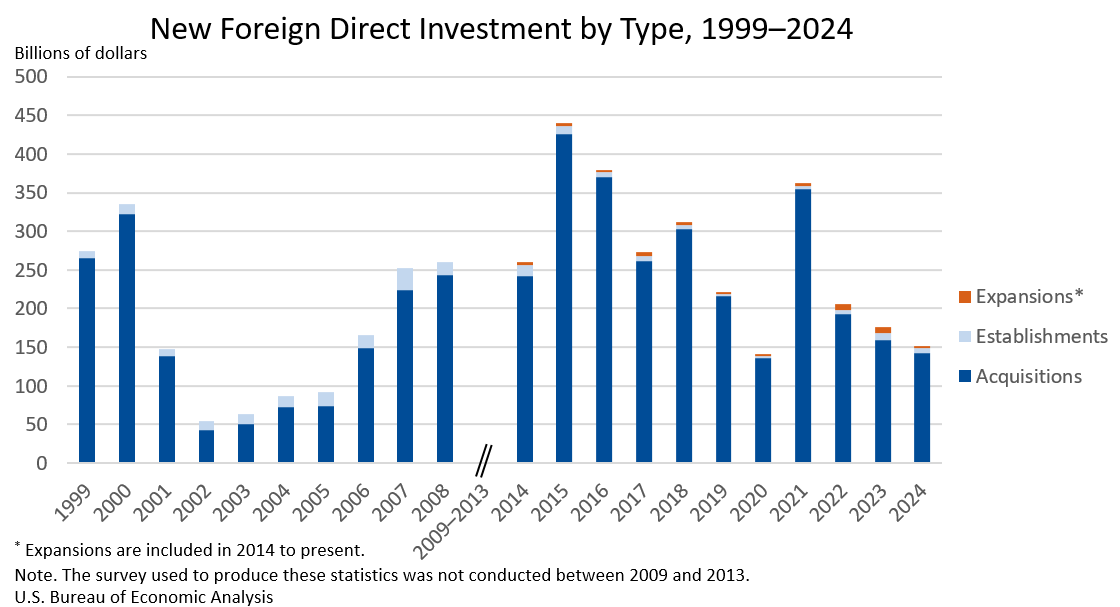Bureau of Economic Analysis
New Foreign Direct Investment in the United States, 2024
Expenditures by foreign direct investors to acquire, establish, or expand U.S. businesses totaled $151.0 billion in 2024, according to preliminary statistics released today by the U.S. Bureau of Economic Analysis. Expenditures decreased $24.9 billion, or 14.2 percent, from $176.0 billion (revised) in 2023 and were below the annual average of $277.2 billion for 2014–2023. As in previous years, acquisitions of existing U.S. businesses accounted for most of the expenditures.
Principal Federal Economic Indicators
Noteworthy
- 2025 News Release Schedule
- Innovation at BEA
- 2025 Annual Updates
- New! Services Trade Data for More Countries
- Data Tool: Trade in Value Added
- Distribution of State Personal Income
- Updated: RIMS II Regional Multipliers
- Arts and Culture
- Space Economy
- FDI Now in State BEARFACTS
- Quick Guide: Price Indexes
The Latest
August 2017 Trade Gap is $42.4 Billion
The U.S. monthly international trade deficit decreased in August 2017 according to the U.S. Bureau of Economic Analysis and the U.S. Census Bureau. The deficit decreased from $43.6 billion in July (revised) to $42.4 billion in August, as exports increased and imports decreased. The previously published July deficit was $43.7 billion. The goods deficit decreased $0.9 billion in August to $64.4 billion. The services surplus increased $0.3…
U.S. International Trade in Goods and Services, August 2017
Total August exports of $195.3 billion and imports of $237.7 billion resulted in a goods and services deficit of $42.4 billion.
Personal Consumption Expenditures by State, 2016
State personal consumption expenditures (PCE) grew on average 4.0 percent in 2016, the same rate as in 2015. In 2016, PCE growth ranged from 0.2 percent in North Dakota to 6.2 percent in Utah.
Personal Consumption Expenditures by State, 2016
State personal consumption expenditures (PCE) grew on average 4.0 percent in 2016, the same rate as in 2015. In 2016, PCE growth ranged from 0.2 percent in North Dakota to 6.2 percent in Utah.
Spending on Durable Goods Falls in August
Personal income increased 0.2 percent in August after increasing 0.3 percent in July. Wages and salaries, the largest component of personal income, was unchanged in August after increasing 0.5 percent in July.
Personal Income and Outlays, August 2017
In August 2017, real disposable personal income decreased 0.1 percent.
GDP Increases in Second Quarter
Real gross domestic product (GDP) increased 3.1 percent in the second quarter of 2017, according to the “third” estimate released by the Bureau of Economic Analysis. The growth rate was 0.1 percentage point more than the “second” estimate released in August. In the first quarter, real GDP increased 1.2 percent.
GDP highlightsThe second-quarter increase in real GDP reflected increases in consumer spending on goods and services as…
Gross Domestic Product, 2nd quarter 2017 (third estimate); Corporate Profits, 2nd quarter 2017 (revised estimate)
Real gross domestic product (GDP) increased at an annual rate of 3.1 percent in the second quarter of 2017 (table 1), according to the "third" estimate released by the Bureau of Economic Analysis. In the first quarter, real GDP increased 1.2 percent. The GDP estimate released today is based on more complete source data than were available for the "second" estimate issued last month.
U.S. Net International Investment Position Second Quarter 2017
The U.S. net international investment position increased to −$7,934.9 billion (preliminary) at the end of the second quarter from −$8,091.6 billion (revised) at the end of the first quarter. The $156.7 billion increase reflected net financial transactions of –$107.5 billion and net other changes in position, such as price and exchange-rate changes, of $264.2 billion.
U.S. International Investment Position, 2nd quarter 2017
The U.S. net international investment position increased to -$7,934.9 billion (preliminary) at the end of the second quarter of 2017 from -$8,091.6 billion (revised) at the end of the first quarter, according to statistics released today by the Bureau of Economic Analysis (BEA). The $156.7 billion increase reflected a $1,004.2 billion increase in U.S. assets and an $847.5 billion increase in U.S. liabilities (table 1).




